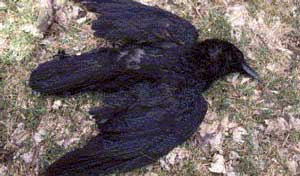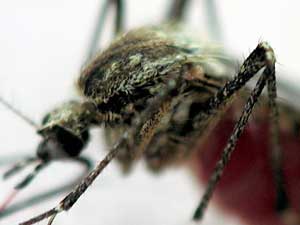|
 (AP)
MINNEAPOLIS - Some people keep ice cream in the freezer.
Terry Selle had a dead crow, but at least he was happy
to share. (AP)
MINNEAPOLIS - Some people keep ice cream in the freezer.
Terry Selle had a dead crow, but at least he was happy
to share.
"It's downstairs in our party room,"
he told Kirk Johnson pleasantly, before leading Johnson
to his basement freezer where he pulled out a newly dead
crow, carefully wrapped in plastic.
Last week, Selle joined the growing ranks
of citizen warriors in the battle against West Nile disease
when he spotted a sickly looking bird and notified authorities.
Birds that drop dead for no apparent reason
- especially crows and blue jays - are often the first
sign that West Nile virus has arrived in an area, long
before any people get sick. It turns out that birds are
far more vulnerable than people to the mosquito-borne
virus.
That's why Johnson, an ecologist with
the Metropolitan Mosquito Control District, and his counterparts
at the state Health Department have appealed to the public
to join in what may seem like a slightly macabre sport:
dead-bird watching. Think of them as the Crow Corpse Corps.
 "We
really can pinpoint where the virus is active at any one
time based on these crow deaths," said Johnson, who
helps collect the birds for testing. "And without
the reports from the public, we really have no idea where
birds are sick and dying." "We
really can pinpoint where the virus is active at any one
time based on these crow deaths," said Johnson, who
helps collect the birds for testing. "And without
the reports from the public, we really have no idea where
birds are sick and dying."
Already, hundreds of reports of doomed
birds have poured into the Health Department this season,
in what has become an annual tradition since 2002, when
the first West Nile case was reported in Minnesota.
So far, few of the birds have tested positive.
But Dave Neitzel, head of mosquito-borne diseases at the
Health Department, knows that's likely to change. In the
past two years, he said, "we found the virus in almost
every county." Last year, 57 percent of the birds
tested in his lab had West Nile virus, up from 43 percent
the year before.
Of course, the investigators are pretty
selective about the ones they test, as callers are often
surprised to discover. Out of almost 10,000 dead birds
reported last year, only 754 were tested. Much of the
detective work, it turns out, is done without anyone leaving
the office.
Last week, three graduate students were
sifting through dead-bird reports and talking to witnesses
by phone, looking for clues. Sometimes, they can rule
out West Nile as a culprit quickly. "This one sounds
like a cat probably got it," Tim Boyer, one of the
investigators, tells a caller. Ever polite, he adds: "Thanks
for calling."
They pass up most of the offerings, Neitzel
said. They have to match criteria such as species, location,
and timing to make them worthwhile. And they're generally
not interested in anything that isn't a crow, blue jay,
hawk or owl.
Says Neitzel: "With all the awareness
of West Nile, people are attaching a little bit more significance
to every bird they find."
Two years ago, callers overwhelmed the
Health Department, which had up to 10 people staffing
the phones, Neitzel said. Since then, they've cut down
on calls by encouraging people to file reports online.
A positive test doesn't mean the people
who live nearby are in special danger, Johnson said, but
clusters of dead birds may lead to stepped-up mosquito-control
efforts.
Last year, West Nile was blamed for 148
human cases in Minnesota, including four deaths. That
means that the chance of getting West Nile Virus in Minnesota
is 3/1,000ths of 1 percent. The Minnesota West Nile Death
Rate is 7/10,000ths of 1 percent.
Nationwide, almost 10,000 cases were reported,
including 264 deaths.
|